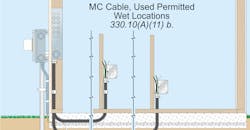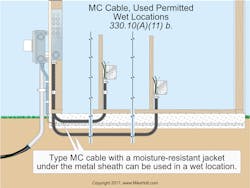Stumped by the Code? Uses Permitted for Metal-Clad Cable (Type MC)
All questions and answers are based on the 2017 NEC.
Underline text indicates a Code change.
Q. What are the uses permitted by the NEC for metal-clad cable (Type MC)?
A. The Code outlines many general and specific uses of Type MC cable. They are outlined in Sec. 330.10 (A) and (B).
(A) General Uses
(1) In branch circuits, feeders, and services
(2) In power, lighting, control, and signal circuits
(3) Indoors or outdoors
(4) Exposed or concealed
(5) Directly buried (if identified for the purpose)
(6) In a cable tray
(7) In a raceway
(8) As aerial cable on a messenger
(9) In hazardous locations as permitted in Sec. 501.10(B), Sec. 502.10(B), and Sec. 503.10
(10) Embedded in plaster or brick in dry locations
(11) In wet locations, where a corrosion-resistant jacket is provided over the metal sheath and any of the following are met:
a. The metallic covering is impervious to moisture.
b. A jacket is provided under the metal covering that’s moisture resistant (Figure).
c. The insulated conductors under the metallic covering are listed for use in wet locations.
(12) If single-conductor cables are used, all circuit conductors must be grouped together to minimize induced voltage on the sheath [Sec. 300.3(B)]. Note: Installing the conductors of a circuit close together will minimize the circuit impedance.
(B) Specific Uses.
Informational Note: The “Uses Permitted” isn’t an all-inclusive list, which indicates that other suitable uses are permitted if approved by the authority having jurisdiction (AHJ).
(1) Cable tray. Type MC cable installed in a cable tray in accordance with Art. 392.
(2) Direct buried. Direct-buried cables must be protected in accordance with Sec. 300.5.
(3) Installed as service-entrance cable. Type MC cable is permitted for service entrances when installed in accordance with Sec. 230.43.
(4) Installed outside of buildings. Type MC cable installed outside of buildings must comply with Sec. 225.10, Sec. 396.10, and Sec. 396.12.
Q. What are the uses not permitted by the NEC for metal-clad cable (Type MC)?
A. Type MC cable isn’t permitted to be used where: [330.12]
(1) Subject to physical damage.
(2) Exposed to the destructive corrosive conditions in (a) or (b) [below], unless the metallic sheath or armor is resistant to the conditions, or protected by material resistant to the conditions:
a. Direct burial in the earth or embedded in concrete unless identified for the application.
b. Exposed to cinder fills, strong chlorides, caustic alkalis, or vapors of chlorine or of hydrochloric acids.
Q. What does the Code require when installing metal-clad cable (Type MC) in exposed work?
A. Exposed runs of Type MC cable must closely follow the surface of the building finish or running boards. Type MC cable installed on the bottom of floor or ceiling joists must be secured at every joist and not be subject to physical damage [Sec. 330.15].
About the Author

Mike Holt
Mike Holt is the owner of Mike Holt Enterprises (www.MikeHolt.com), one of the largest electrical publishers in the United States. He earned a master's degree in the Business Administration Program (MBA) from the University of Miami. He earned his reputation as a National Electrical Code (NEC) expert by working his way up through the electrical trade. Formally a construction editor for two different trade publications, Mike started his career as an apprentice electrician and eventually became a master electrician, an electrical inspector, a contractor, and an educator. Mike has taught more than 1,000 classes on 30 different electrical-related subjects — ranging from alarm installations to exam preparation and voltage drop calculations. He continues to produce seminars, videos, books, and online training for the trade as well as contribute monthly Code content to EC&M magazine.

